- Home
- Steven Pressfield
Killing Rommel Page 6
Killing Rommel Read online
Page 6
“JUMA Three, JUMA calling. Keep going. Report what you see. Off to you.”
That’s us. In my bucking, heaving turret, pressing the small of my back into the rim of the hatch with one knee braced against the rack that holds my Mills bombs, my spare glasses and the four books I’m reading, and the other wedged against the side of the breech guard of our 2-pounder gun, I wave Corporal Pease in the point tank forward. We’re advancing at about five miles an hour. My binoculars are riveted to my eye sockets. The ride is like a small boat at sea. Petrol and machine oil reek. The surface of the turret is so hot from the sun that it burns my elbows through my shirt. Inside the tank, the temperature is well into triple figures.
Now I see our “friends,” two armoured cars of 3KDG, 3rd King’s Dragoon Guards, darting back towards us, hollow to hollow, like waterbugs. I can’t see the cars themselves, only their dust, which I recognise. We’re all learning, day by day. I wish I were a seasoned tank commander. I’m not. I’m faking fifty percent of everything. The enemy’s skills are leagues beyond ours, as are his tactics and equipment. We know it and so does he. I’m not frightened; there’s no time for that; too much concentration is required. But I’m keenly aware of my own deficiencies and those of my crew and my guns and my commanders. It is not a reassuring feeling.
Ahead lies a ridge with a hollow into which a tank can slip without exposing itself on the skyline. I order Pease to take the wing; I advance myself into this pocket. “Driver, halt.” So I can see. A breeze clears the vantage south. External temperature is 110 Fahrenheit. Through the binoculars I can make out two columns of dust, advancing southeast round our flank. The first is tanks; the trailing column, five miles back, is enemy M.T.—motor transport—petrol and ammunition trucks. “Hello JUMA, JUMA Three calling.” I report what I see.
“Hello JUMA Three, JUMA answering. Hold where you are. Wait for orders.”
Up the ridge in front of us scuttles a waterbug, one of our KDG armoured cars. It zips up alongside and stops. On its prow is painted “Tink 21” above an excellent rendering of a bathing beauty straddling a Breda gun. Its driver is a sergeant I don’t recognise. He grins up. “Haven’t got a smoke, have you, guv?” I toss him a pack of four horrible Chelseas from the clutch I keep in the wireless rack. “What’s up front?” I ask. He lights two cigs and passes one overhand to his driver, through the port. “Half the bloody Hun army.” He has had to beat it, he says, from lorried infantry and big German 8-wheelers, armoured cars, coming up at the same time as at least fifty Mark IIIs and IVs. “A sight,” says the sergeant, “to make me piss me bleedin’ pants.”
Enemy infantry up front means they’re protecting anti-tank guns, which means trouble for us.
“Hello, all stations JUMA, JUMA calling. Orders: Wheel south, come on line, and engage enemy supply column. Off.”
We do. Now the stopped German tanks start rolling forward; they burst through our vacated position before our follow-on elements can advance into place to counter them. South on the flat, the German supply column breaks away long before we reach it, warned by our dust and, no doubt, wireless intercepts. Our attack buckles in the face of a screen of furious anti-tank fire; we are compelled to retreat yet again when the west-leading column of Panzers comes about and threatens to cut us off. I lose Pease’s tank when an HE round turns its right track and suspension into spare parts, and I lose its driver to a broken jaw when a round of solid shot opens up one side of his turret. Darkness approaches. Corporal Ledgard is my Number Three tank commander. As he and I take the crew off and hustle back into the protective perimenter of vehicles and infantry that we call a night leaguer, we can see two Mark IIIs closing in to claim the prize of Pease’s A-13. By midnight German salvage crews will have towed it back to a mobile repair shop. In five days we’ll see it again, with a black cross painted on its flank and an Axis crew inside.
The day is over. We’re alive, we haven’t been put in the bag, haven’t disgraced ourselves. But we haven’t accomplished a damn thing either, and in fact we’re about to sit down twenty miles east of where we started. As darkness descends and our squadrons retire in weary, dust-caked columns, we know the enemy are not reeling as we are, but remain keen and eager, anticipating the dawn when they will throw their formations upon us again and we will face them with our same inferior tactics, armour and weaponry.
It’s a sickening feeling, knowing the enemy has your number. We can feel the force of Rommel’s genius. He calls the tune, we dance—and always one step behind. Rommel concentrates his armour; we fritter ours away in dribs and drabs. His Panzers never attack but in mass. When you see Axis tanks, you see columns and phalanxes; it looks as if the whole world is coming at you. The enemy’s style is ripping, audacious. They are all little Rommels. Opening the merest breach, they exploit it ruthlessly and without hesitation. They turn small victories into big ones. On our side, we’re bold but not smart; our rushes are like the Charge of the Light Brigade, all flash and no sense. Now in night leaguer, troop and squadron commanders assemble at Colonel L.’s command truck, ducking through the blackout blanket into the cigarette-and pipe-smoke-dense interior. We can sense control slipping. The field is too broad, the enemy too swift and unpredictable. Squadron commanders ask L. for the foe’s position. He doesn’t know. Brigade doesn’t know. Division doesn’t know.
Days of disorder follow. We have no answer for Rommel’s armour, firepower or speed. The Afrika Korps’ tactics are to throw tanks and anti-tank guns forward in tandem, either to seize some strategic ground that threatens our flank or route of withdrawal, or to advance frontally in such strength that we must counter or be overrun. Since the range of our guns won’t let us slug it out at long distance, we have no choice but to close with the foe. This is exactly what he wants. We fling our outgunned, underarmoured Honeys and Crusaders at Rommel’s Mark IIIs and IVs, which immediately reverse out of range, leaving us to run on to his dug-in, diabolically sited 88s and Pak 38s. The anti-tank guns tear us apart. When the foe’s officers spot enough flamers and gun-downs, their Panzers reappear. With every clash, we lose more men and more tanks.
Our line falls back again and again. In the confusion, elements scatter. Regiments crack up. Brigades break apart. Entire squadrons go missing. The civilian may react with incredulity. How can vehicles as massive as tanks get separated from one another in flat, open desert? But a brigade on the move spreads out over scores of miles. When the terrain is broken, when sandstorms and dust storms get up, when midday glare obscures vision or the tanks must move in darkness, if the column comes under fire and individual elements must move swiftly in attack or retreat, not only is it the easiest thing in the world to get separated, but in fact it requires tremendous concentration and presence of mind not to get separated. The norm is to be separated. One learns how to arc tracer fire, “toffee apples,” into the night sky to show your mates where you are so they can help you navigate by wireless as you grope your way home.
In the Cauldron clashes, as these battles have come to be called after the name of the minefields round Knightsbridge, our squadron loses eight tanks out of sixteen; at King’s Cross south of Tobruk, my troop of four drops down to one, then zero. Pease has had four tanks shot out from under him; I’ve had three. As refits come up after dark, each troop commander grabs what he can. Faces cycle through as fast as machines. In column rumbling into night leaguer, we run into fellows we have never seen before—individual tanks separated from their squadrons, regiments, brigades. Day Seven since the fall of Bir Hacheim, it happens to us. We’re lost. I have two strange tanks and all strange crews; our scratch lot end up with what remains of 4th Armoured Brigade, who have themselves been tossed in with unallied companies of Indian and South African infantry.
As organisation breaks down across the vast and muddled field, improvisation becomes the order of the day. Proper radio protocol requires tank troop and squadron commanders to communicate only within their own regiment; it’s a court-martial offence to go over or roun
d. Now commanders are poaching on any net they can break into, seeking aid from any allies they can find. Day Nine, retreating to a defensive line thrown together on the Tobruk—El Adem track, I’m tapping on to an artillery net when I hear a familiar voice. “Hell’s bells, is that Chapman from Magdalen?”
“Who’s this?”
It’s Stein. His two batteries of 25-pounders (or such sections as remain intact and functioning) have somehow thrown in with those elements of our regiment that still cling together. Two nights later, he and I find each other in leaguer, outside Colonel L.’s command truck.
Stein is a captain now, an acting major. I barely recognise him. A grisly burn-scar paints one side of his face. Shrapnel, another officer tells me, has left one of his knees half-frozen. Stein is cut about but flying high. Captains and lieutenants defer to him; he’s their chief and they love him.
Something extraordinary is happening. Under the stress of withdrawal and dislocation, with the chain of command cast into anarchy through wounds and deaths, vacuums of leadership have begun to appear. Many commanding officers rise brilliantly to the occasion, but others falter, fail or in effect abdicate. In numerous formations 2/ICs, seconds-in-command, are compelled to step forward. This is the case with Stein. He’s only a captain but he’s running the show of a colonel. He does it so smoothly we barely notice. From his demeanour and the confidence with which he issues orders, not to mention the alacrity with which they are obeyed, I assume his post is battery commander. It takes a night or two before I realise his name isn’t even on the top sheet of the War Establishment. He has simply taken over, or rather been called forth by the moment.
Stein has always been a brilliant teacher. He employs this faculty now. Earlier in the retreat, when batteries of 25-pounder guns have come under fire, they have simply packed their kit and poodled off. Most are still doing so. Stein puts a stop to this. He has two batteries; he alternates them, forward and rear, keeping one up front with the tanks, firing over open sights if necessary, the outfit so far forward that at times they’re actually out front of the armour. He drills his gun crews to “set up, sight up, light up”—then fall back to a new position and do it again. Stein recruits OPs—forward observers—from displaced infantry, ambulatory wounded and from “B” echelon troopers whose trucks have broken down or been shot up, giving them patched-together wirelesses and salvaged Bren carriers or Morris pickups and teaching them how to call in fire orders. He keeps his object simple: “Make life bloody for Rommel’s 88s.”
We have an officer like him in our own regiment. This is Major Mike Mallory, second in command under Colonel L., whom I ran into on the Sollum serpentine. Mallory had been a theatrical producer in London (he had had a hit with Irene Cawley in Her Sweet Fancy just before the war). Whether this background in some way prepares Mallory for command, no one can say. We know this, though: L. will not get us out of this fix. Impelled by instinct for survival, the junior officers rally to Mallory. We listen to him. We do what he says. He becomes de facto battalion commander, with Stein and two or three other captains and majors of allied arms in support.
High command has lost control of the field. Brigade can’t locate its constituent elements on a map, let alone find the enemy, or work out what to do with either. My diary records a run of four days when either no orders at all come in, or when they do they are so out of touch with affairs on the ground, that to obey them would produce an even graver tragedy than what is already happening. “I can’t make head or tail of this, can you?” says Mallory of one particularly egregious signal. When he bins it, all hands cheer.
Mallory issues his cardinal order. “From this hour, all heroism is forbidden. If I hear of one officer making some valiant ‘charge’ or taking some gallant ‘stand,’ by heaven, I’ll find him myself and wring his bloody neck.”
Mallory outlaws all undisciplined retreat. “One cannot simply pack up and piss off. It’s bad manners.”
Our new leader restores order. He gives us heart. He defines the problem and provides a solution. “The enemy attack with tanks and anti-tank guns working together. He advances in massed order, while we hurl ourselves at him in penny packets. This is suicide. From now on, we advance and withdraw as one unit, supporting one another.”
Except the Grants with their 75mms, Eighth Army has no tank gun that can fire a high-explosive shell, the kind you need to knock out Rommel’s 88s and their crews. The solid shot of our Honeys and Crusaders are worthless against such targets.
This is where Stein comes in. Working with Mallory, he brings up his 25-pounders, which can fire HE, and he keeps them close. This is a desperately risky business, for such artillery are hell to move out in a hurry; it takes minutes for them to limber up and flee, should Rommel’s gunners get their range or his infantry bring them under fire. So we tanks must stay with them. Stein’s 25-pounders are the only weapons we have against the Afrika Korps’ 88s and Paks, and the only guns that can take on Mark IIIs and IVs beyond a thousand yards. We are in this together. This is not tactics, it’s life and death.
“Listen to me, friends,” Mallory instructs us in night leaguer. “One act I will never stand for is leaving our fellows behind. Bugger military protocol or lofty notions of honour. I can’t live with running out on a pal, and I won’t let any of you do it either.”
This is the sort of stuff we need to hear.
Our condition is preposterous, really. We are like civilians seeking to bring common sense to bear upon problems that we should have been trained for but have not been. Worse, we must get our new lads up to speed, sometimes during the very night preceding their first action, while we ourselves are nearly as green as they. Fresh “bods” come up from the rear and are made corpses almost before we learn their names. Stein takes this hard. All our young officers do.
Night Thirteen, Stein and I get a few minutes together, after each has completed his duties of the evening. We perch on the tailboard of a fitter’s truck and share cold tea and rum from the very flask that Stein had revived me with that night at Winchester. I ask whether he’s still writing poetry.
“No, by heaven, and I shan’t ever again.” He indicates the tanks and men round about. “Stuff like this calls for prose, Chap. Short sentences, pithy and lean.”
I tell Stein how impressed I am with him—and how different he seems from our days at university.
“Not actually. All that’s changed is we’ve switched from men of words to men of action. And a damn relief too!”
Stein tells me that when he first got out to Egypt, he applied for the Long Range Desert Group. “It seemed like what Lawrence would have done.” He means T. E. Lawrence, Lawrence of Arabia, our fellow Oxford man.
I tell Stein of my own failed application to the LRDG. “Did they accept you?”
“Division squashed the deal. Said they couldn’t spare artillery officers. The fools! I’d have been damn smart out there among the prophets and the scorpions.” Stein laughs. “I must tell you something, Chap, that I daren’t confess to another soul. I’m having the time of my life.” He shakes his head. “It’s outrageous to declare such a thing, I know, with dear friends getting blown to pieces and England’s own survival hanging by a thread. But, by God, life is brilliant out here, isn’t it?”
He asks if I’ve ever had a premonition of my own death. I tell him I follow the advice of my drill sergeant from Bovington: Stay dumb and don’t think.
“Will you take this for me, my friend?” And he slips a folded envelope into my breast pocket.
“What is it?”
“It makes you executor of my estate.”
“Don’t joke around, Stein.”
He’s serious. He asks if I recall our conversations about the twentieth century and how much he abhors it. “All that is behind us, Chap. We’re living in the time before Christ.” He laughs and indicates the desert round our camp. “We’re a tribe. We’ve become that. The Huns too. The poor bastards.”
He hoists the flask. “Do you kn
ow,” he says, “I used to feel apart from men of the trades, as my father would call them. Other ranks. No more. Out here I’ve come to love them. Officers too. Hell’s bells, I love even the Jerries, the bloody swine.”
He says if he writes anything in future, it will be damn serious. Life and death. But it’ll be funny. The gods themselves laugh, he says. “And not darkly, but with joy.”
Mallory comes up, our leader. “What are you two on about?”
“Nothing you’d understand,” says Stein, passing him the flask.
“Well, break off for a bit, will you?” Mallory indicates the command truck, at which other officers are now collecting, apparently for a late-hour change in orders. “Let’s see if we can conjure a way out of this mess for one more day.”
6
21 JUNE, Tobruk falls. With that, Rommel acquires a seaport within three hundred miles of Alexandria—and we lose our last stronghold in Cyrenaica. The gallop is on, back to Cairo.
Two episodes give the flavour of the retreat. The first involves Colonel L. Our commander is painfully aware of his displacement in the men’s hearts by Mallory. He feels shame over this and takes to reasserting his authority by spasms. Falling back in the desert between Sidi Aziz and Fort Capuzzo, our troop of “A” squadron is ordered by L. to take up a defensive position at a feature identified on the map as Hill 99. We arrive with our sister troops, eleven tanks in all, and set up hull-down along the ridgeline, facing west. Within minutes shells begin dropping amongst us, first the airburst high explosive that 88s use for ranging; then straight HE, possibly from Mark IV Panzers, though we can’t see; then even bigger shells that Pease identifies as 105s from field guns. This fire is coming not from in front, where the enemy are supposed to be, but from behind and left. What the hell is going on?

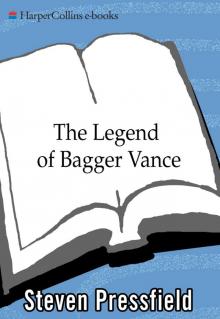 The Legend of Bagger Vance: A Novel of Golf and the Game of Life
The Legend of Bagger Vance: A Novel of Golf and the Game of Life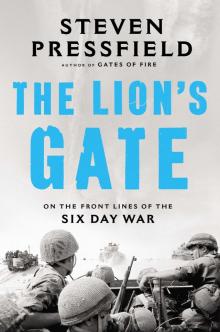 The Lion's Gate: On the Front Lines of the Six Day War
The Lion's Gate: On the Front Lines of the Six Day War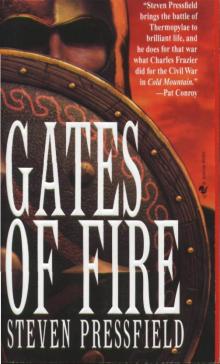 Gates of Fire
Gates of Fire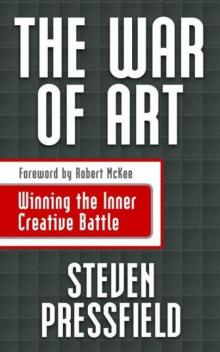 The War of Art
The War of Art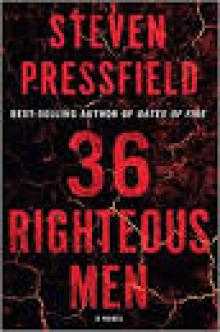 36 Righteous Men
36 Righteous Men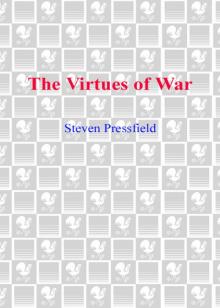 The Virtues of War
The Virtues of War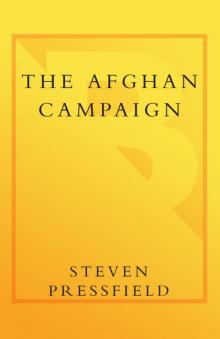 The Afghan Campaign
The Afghan Campaign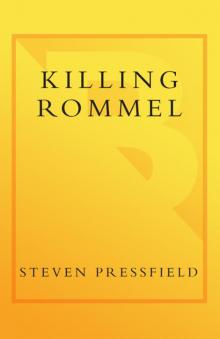 Killing Rommel
Killing Rommel Last of the Amazons Last of the Amazons Last of the Amazons
Last of the Amazons Last of the Amazons Last of the Amazons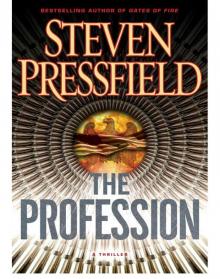 The Profession
The Profession Last of the Amazons
Last of the Amazons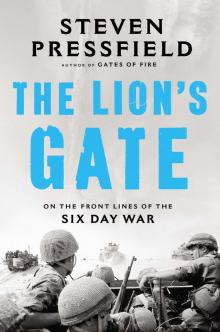 The Lion’s Gate
The Lion’s Gate The Legend of Bagger Vance
The Legend of Bagger Vance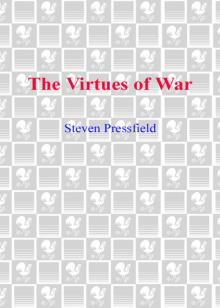 Virtues of War
Virtues of War Tides of War, a Novel of Alcibiades and the Peloponnesian War
Tides of War, a Novel of Alcibiades and the Peloponnesian War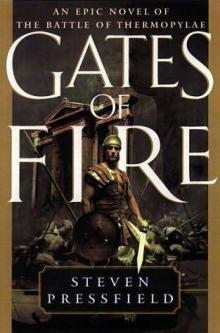 Gates of Fire: An Epic Novel of the Battle of Thermopylae
Gates of Fire: An Epic Novel of the Battle of Thermopylae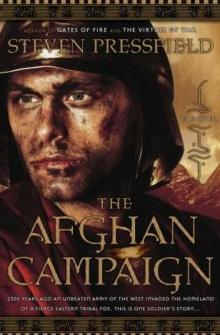 The Afgan Campaign
The Afgan Campaign